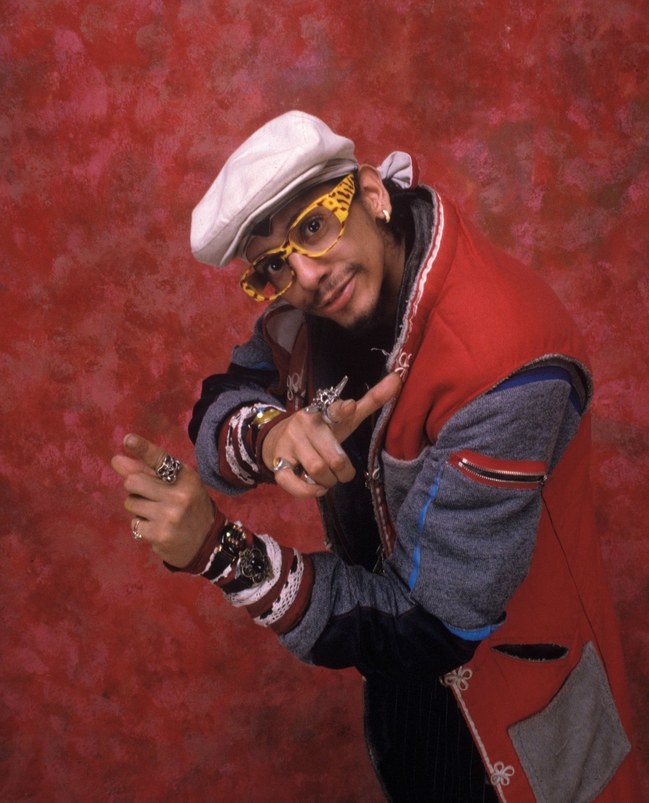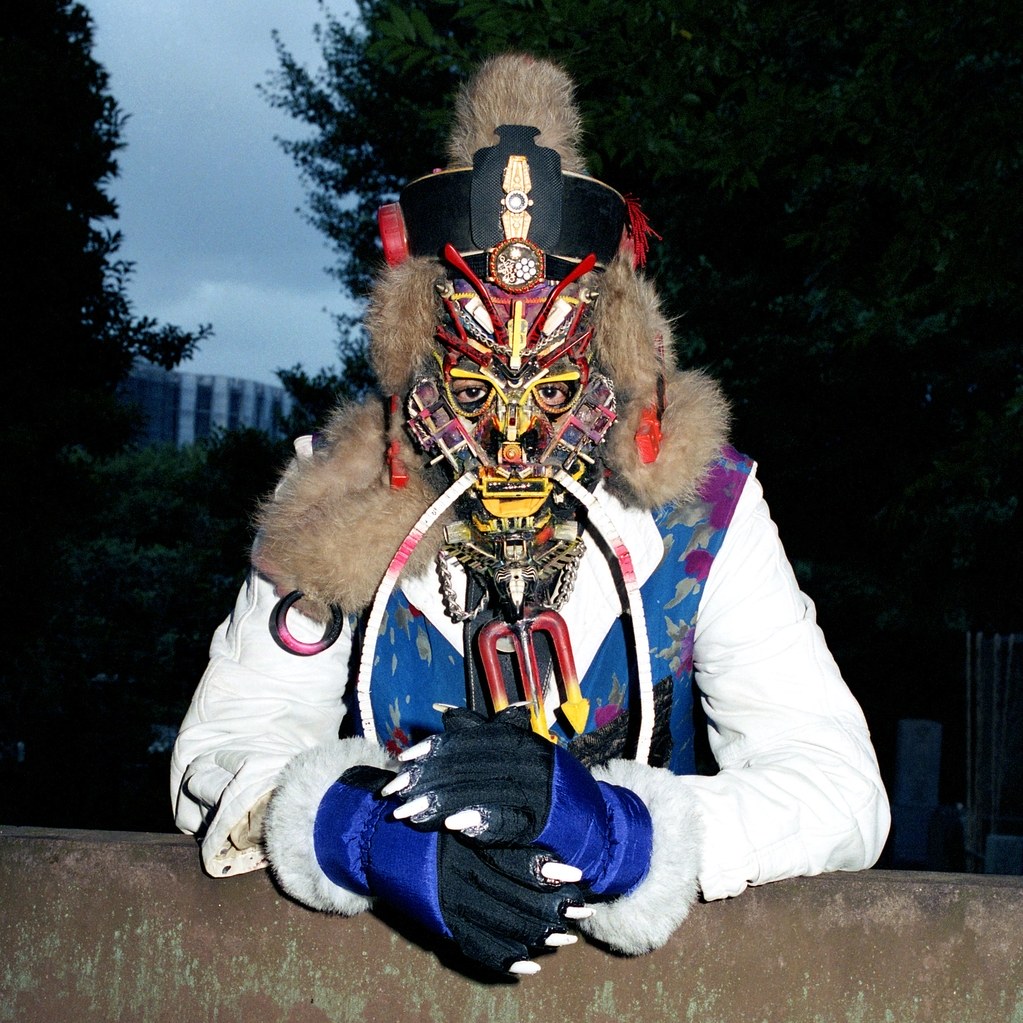The Spectacular Personal Mythology of Rammellzee
Drawing from philology, astrophysics, and medieval history, Ramm channelled the chaos of seventies New York through his art and music.

Rammellzee channelled the city’s chaos into a spectacular personal mythology
In the late nineteen-seventies, the sociologist Nathan Glazer had grown weary of riding New York’s graffiti-covered subways. The names of young vandals, who identified themselves as “writers” rather than as artists, were everywhere—inside, outside, sometimes stretching across multiple train cars. Glazer didn’t know who these writers were, or whether their transgressive spirit ever manifested itself in violent crimes, but that didn’t matter. The daily confrontation with graffiti suggested a city under siege. “The signs of official failure are everywhere,” he wrote in an influential 1979 essay. Graffiti, with its casual anarchy and cryptic syntax, offered glimpses into a “world of uncontrollable predators.” In the nineties, Glazer’s essay would help inspire the concept of “broken windows” policing—a theory that preserving the appearance of calm, orderly neighborhoods can foster peace and civility.
Graffiti has always had this kind of metaphorical power. It is somehow more than art or destruction (even though it is both), and it prompts awe or dread, depending on your tolerance for disorder. For every Glazer, there were romantics like Norman Mailer, who had written the text for a book of photographs elevating graffiti to the status of “faith.” From his perspective, graffiti forced the upper crust to reckon with the names and the fugitive dreams of a forgotten underclass: “You hit your name and maybe something in the whole scheme of the system gives a death rattle.”
Few people understood and internalized this power as deeply as the artist, rapper, and theoretician Rammellzee (which he styled as The ramm:ell:zee). He believed that his time in the train yards and the tunnels of New York gave him a vision for how to destroy and rebuild our world. He was born in 1960 and grew up in Far Rockaway, Queens. His birth name is a closely guarded secret; he legally changed it to his artistic tag in 1979. (He also insisted that The ramm:ell:zee was an “equation,” not a name.) Little is known about his youth, aside from passing aspirations to study dentistry (he was good with his hands) and to be a model (in a 1980 catalogue, he is identified as Mcrammellzee).
Ramm—as he became known—believed that language enforced discipline, and that whoever controlled it could steer people’s thoughts and imaginations. His hope wasn’t to replace English; he wanted to annihilate it from the inside out. His generation grew up after urban flight had devastated New York’s finances and infrastructure. Ramm channelled the chaos into a spectacular personal mythology, drawn from philology, astrophysics, and medieval history. He was obsessed with a story of Gothic monks whose lettering grew so ornate that the bishops found it unreadable and banned the technique. The monks’ work wasn’t so different from the increasingly abstract styles of graffiti writing, which turned a name into something mysterious and unrecognizable. Ramm developed a philosophy, Gothic Futurism, and an artistic approach that he called Ikonoklast Panzerism: “Ikonoklast” because he was a “symbol destroyer,” abolishing age-old standards of language and meaning; “Panzer” because this symbolic warfare involved arming all the letters of the alphabet, so that they might liberate themselves. He lived these ideas through his art and his music, and by being part of the hip-hop scene during its infancy.
In 1983, Rammellzee and a rapper named K-Rob went to visit the painter Jean-Michel Basquiat. Though Ramm and Basquiat were friends, they were also rivals. Ramm would later say that Basquiat wasn’t a “dream artist”—he didn’t so much radiate visions outward as take things in like a “sponge,” learning about genius from books. He and Ramm once bet on who could most convincingly parody the other’s work. (Ramm claimed not only that he won but that Basquiat’s art dealer, who wasn’t in on their ruse, told Basquiat that “his” work was the best he had ever done.)
That night, Basquiat invited Ramm and K-Rob to record a song he’d written. Ramm, who had rapped in the movie “Wild Style,” was already known for his unique nasal sneer. (He called it his “gangster duck” style.) The two men looked at Basquiat’s elementary rhymes, laughed, and tossed them in the trash. Instead, they made up their own lyrics—a brilliant, surreal tale of a kid (the earnest, bemused K-Rob) who’s on his way home and a hectoring pimp (Ramm) who tries to tempt him toward the dark side. Basquiat called the song “Beat Bop,” and paid for it to be produced; he painted the vinyl single’s cover art himself. The song was murky and strange, like a spiky funk jam slowed to a sinister crawl. In the background, someone tunes a violin. There’s so much echo and reverb on the track that it sounds like an attempt at time travel.
In the eighties, graffiti gained acceptance in the art world. Despite Ramm’s charisma, the intensity of his work and his stubborn, erratic personality kept him on the movement’s fringes. Where Basquiat and Keith Haring seemed shy showmen, Ramm came across as a nutty professor. His early paintings took inspiration from the psychedelia of comic books and science fantasy, with mazy train tracks running across cosmic reliefs. His palette was attuned to the era’s anxieties about nuclear war and nuclear waste. The colors were bright and garish, suggesting a box of neon highlighters run amok.

Rammellzee created and wore full-body suits of armor that he called “Garbage Gods.”
In the mid-eighties, he began rendering these ideas in 3-D. He made sculptures that evoked the fossilized remains of twentieth-century life: newspaper clippings, key rings, chain links, and other junk, floating in an epoxy ooze. The most remarkable works were his “Garbage Gods,” full-body suits of armor, some of which weighed more than a hundred pounds. They look like junk-yard Transformers doing samurai cosplay. His most famous character, the Gasholeer, was outfitted with a small flamethrower.
Ramm’s art, thought, and music are the subject of the exhibition “ramm∑llz∑∑: Racing for Thunder,” at Red Bull Arts New York. Befitting the popular drink’s own sense of iconoclasm, “Racing” bathes in Ramm’s frenzied, free-associative, and occasionally overwhelming energy. There are his early canvases and sculptures, along with flyers, business cards, manifestos, and patent applications. A small theatre screens previously unseen videos of Ramm rapping at night clubs. The most impressive part of the survey is a floor devoted to his “Garbage Gods” and “Letter Racers”—skateboards representing each letter of the alphabet, armed with makeshift rockets, screwdrivers, and blades.
Throughout the exhibition, you can hear moments from Ramm’s lectures on Gothic Futurism—a thrilling jumble of street-corner hustling and technical language, all “parsecs,” “integers,” “aerodynamics.” As I was examining a collection of hand-painted watches, I kept hearing Ramm pause as he reached the end of a long disquisition on ecological catastrophe and graffiti-as-warfare, and then bark, “Next slide!”
In early May, the Red Bull Music Festival staged a Ramm-inspired concert to mark the opening of the art show. Ramm had continued to make music after “Beat Bop,” never wavering from his philosophies, just declaring them against increasingly turbulent, industrial-sounding backdrops. The eclecticism of the bill spoke to his wandering ear, and ranged from the terse hardcore of Show Me the Body to the wise-ass raps of Wiki. K-Rob, wearing a T-shirt featuring a mushroom and the words “I’m a Fun Guy,” reprised his verse from “Beat Bop,” grinning the whole way through. Gio Escobar, the leader of the deft punk-jazz band Standing on the Corner, dedicated a song to a late friend. The departed are everywhere around us, he said, as a groove emerged from the band’s dubbed-out chaos. “And they’re waiting.”
As hip-hop and art changed, as graffiti vanished from New York’s trains and walls, Ramm delved further into his own private cosmos—namely, the enormous loft in Tribeca where he lived, which he called the Battle Station. His obscurity wasn’t a choice. In the early eighties, he offered to send the U.S. military some of the intelligence he had gathered for national defense. (It declined.) In 1985, he wrote an opera, “The Requiem of Gothic Futurism.” In the nineties, he tried to promote his ideas by producing a comic book and a board game. He thought that toy manufacturers might want to mass-produce his “Garbage Gods” models. He was the first artist to collaborate with the streetwear brand Supreme. There was a series of infomercial-like videos to seed interest in “Alpha’s Bet,” an epic movie that he hoped would finally resolve the narrative arc of his extended universe.
By the time Rammellzee died, in 2010, after a long illness, New York City had been completely remade by mayoral administrations that took broken-windows policing as gospel. The Battle Station became condos. The Internet has made it easy to take what the culture provides you and rearrange it in some novel, cheeky way. It’s much more difficult to build an entirely new world—to abide by an ethical vision with a ferocity that requires you to break all the rules. I was surprised by how moved I felt standing underneath Ramm’s “Letter Racers” and studying the textures of the “Garbage Gods.” To see their meticulous handiwork up close was to believe that Ramm’s far-flung theories, his mashup of quantum physics and “slanguage,” made sense as an outsider’s survival strategy. I noticed all the discarded fragments of city life—bulbs and screws, a billiard ball, a doll’s head, old fan blades and turn-signal signs, visors stacked to look like pill bugs. His commitment was total. These are works of devotion.
This is where Ramm wanted to live—at the edge of comprehensibility, but in a way that invited others to wonder. Cities are filled with strangers who possess an unnerving energy, who hail us with stories, songs, and poems. Ramm was one of these. In an interview filmed in the aughts, Ramm sheds light on his everyday life. Sometimes, he says, he’ll be walking down the street or sitting at a bar, and people will just look at him. And sometimes they’ll come up to him and ask, “Who are you?” He’s explaining all this while wearing one of his “Garbage God” masks. You notice his paunch, the warm crackle of his voice at rest. “I’m just an average Joe,” he says, and he sounds like he believes it.
Source: The New Yorker
